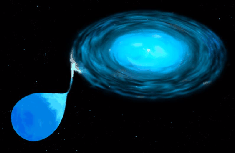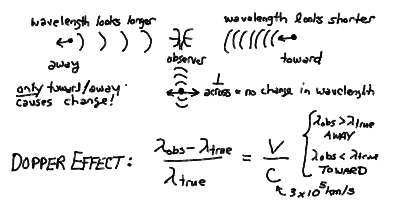Lecture 6 - Spectroscopic and Eclipsing Binaries (1/28/99)
 Binaries I --- | ---
H-R Diagram
Binaries I --- | ---
H-R Diagram


Reading:
Chapter 12 (ZG4)
Notes:
pages 20 - 23
Artists conception of an X-ray binary star. The two
stars are so close together that the larger star spills over onto the
white dwarf companion, which gets heated and emits X-rays.
(Courtesy NASA/STSCI)
 |
Key Question: |
How can you measure the radius
of a distant star?
|
|---|
 |
Key Principle: |
Mass Function for Binary Stars
|
|---|
 |
Key Problem: |
Determine densities and radii of
Sirius A & B.
|
|---|
Investigations:
- Spectroscopic Binaries
- What is a Dopper shift?
- How do you find radial velocity from the observed wavelengths of
spectral lines?
- What is the radial velocity corresponding to a 1 Angstrom shift at
5000 Angstroms rest wavelength?
- What is the shift corresponding to a 1 km/s radial velocity at
5000 Angstroms?
- What is the resolving power of a high resolution spectrograph
needed to measure radial velocities with < 1 km/s accuracy?
- What is the orbital velocity of the Earth around the Sun?
- What is the orbital velocity of the Sun induced by Jupiter?
- What is a double-line spectroscopic binary?
- What role does the inclination of the orbit play in the observed
velocities?
- How do you find the masses from a double-line binary?
- What is a single-line spectroscopic binary?
- What is the mass function for a binary star?
- How do you find the mass function of a single line binary?
- What is the significance of the mass function, given that the total
mass and the inclination are unknown?
- What effect do orbital eccentricity and inclination have on the
observed velocity curves?
- Eclipsing Binaries
- What is the likely inclination and/or separation of an eclipsing
binary system?
- How do you recognize an eclipsing binary system?
- What are the times of 1st - 4th contact?
- How do you find the radii of the stars from the light curves?
- How are the depths of the eclipses related to the temperatures
of the stars? Why?
- If the eclipsing binary is also spectroscopic, what additional
information can be learned?
- Example (see homework 1):
Sirius A & B - Radii and Densities
- System Data II -
| Bolometric Magnitude (Sirius A): | +1.33 |
| Bolometric Magnitude (Sirius B): | +8.57 |
| Bolometric Magnitude (Sun): | +4.76 |
| Effective Temperature (Sirius A) | 9200 K |
| Effective Temperature (Sirius B) | 27000 K |
| Effective Temperature (Sun) | 5770 K |
- What are the luminosities of Sirius A & B in Lsun?
- What are the radii of Sirius A & B?
- What are the mean densities of Sirius A & B?
- Where on the H-R diagram do Sirius A & B lie?
- What stellar classifications would you give to Sirius A & B?
The Doppler Effect
The Doppler effect:

 Prev Lecture ---
Prev Lecture ---
 Next Lecture ---
Next Lecture ---
 Astr12 Index ---
Astr12 Index ---
 Astr12 Home
Astr12 Home
smyers@nrao.edu
Steven T. Myers
 Binaries I --- | ---
H-R Diagram
Binaries I --- | ---
H-R Diagram

 Binaries I --- | ---
H-R Diagram
Binaries I --- | ---
H-R Diagram






 Prev Lecture ---
Prev Lecture ---
 Next Lecture ---
Next Lecture ---
 Astr12 Index ---
Astr12 Index ---
 Astr12 Home
Astr12 Home